In-plane shielding cutshead CT dose overspill
The contribution made by CT to the cumulative population radiation dose, as a proportion of all medical examinations, continues to rise.
The contribution made by CT to the cumulative population radiation dose, as a proportion of all medical examinations, continues to rise. The number of CT scans performed in the U.S. increased from 2.8 million 1981 to 50 million in 2003.1 CT contributed 20% of the collective radiation dose in the U.K. in 1989.2 By 2003 this had risen to 47%.3
Today, CT accounts for 50% of the U.K. population's medical radiation burden, but just 6% of diagnostic examinations. This is most likely to be due to the wide availability of multislice CT systems and the increasing number of clinical applications where CT is called for.
All individuals involved with a patient's care have a responsibility to ensure the implementation of dose reduction strategies. Clinicians must ensure that the indications warrant CT, radiologists should be available to accept or reject requests, and radiographers should make certain that the optimum diagnostic imaging acquired at a dose which is as low as is reasonably practicable (ALARP).
A compromise must be met between diagnostic quality and radiation dose in most investigations that use ionizing radiation. In the modern protocol-driven healthcare setting, however, the issue of optimum quality has yet to be resolved.
Each individual center will use their own, preferred technique to produce the highest quality diagnostic images by balancing a variety of factors. This practice is often based on tradition and/or manufacturers' recommendations, and may lead to differing dose levels. Results from clinical surveys confirm that there is a wide variation in the practice of head CT and the dose levels involved in these scans. One survey of 945 head CT examinations, performed at many different centers, found that 94% of patients were scanned sequentially and 6% helically - but there were 118 different protocols.4
Substantial dose reduction can be achieved through the careful selection of exposure factors and appropriate positioning techniques. Such variables should ideally be standardized if variations in patient radiation dose are to be reduced.5
Specific patient dose limits are not enforced by legislation, though the ALARP principle dictates we should be able to justify our techniques, protocols, and procedures in terms of the radiation dose delivered. Dose reference levels (DRLs)6 have now become firmly embedded in CT culture, and are a first step towards the introduction of standardized doses for individual CT examinations.4
SENSITIVE SITES
The lens of the eye is the most radiosensitive organ within the head. A standard CT head scan delivers approximately 50 mGy of radiation to the eyes. A dose of 0.5 to 2 Gy can cause detectable opacities, whilst anything above 4 Gy can cause visual impairment.7,8 Children's eyes are even more radiosensitive. It has been suggested that a dose of 0.5 to 1 Gy is cataractogenic.9
The lens dose for a single scan series is considerably less than the threshold dose for cataract formation. Consideration must be given, however, to the cumulative effect on patients who have multiple examinations, potentially at a younger age, and to growing life expectancy.5 There is no evidence that diagnostic imaging procedures lead to the formation of lens cataracts, but this could potentially become an issue if CT usage continues to increase and dose issues are not addressed.10,11
Various authors have suggested ways to reduce the dose to the lens of the eye. Most proposals involve the adoption of different baselines/gantry angulations, and the use of in-plane shielding.
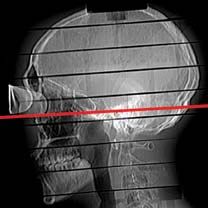
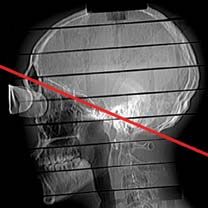
Either the infraorbital meatal baseline (Figure 1) or the supraorbital baseline (Figure 2) may be used when scanning a patient's head. The choice of baseline typically depends on hospital tradition, radiologists' preference, patient population, and the referring neurology center's protocol.
Changes in the scanning plane by using different gantry angulations can affect the radiation dose to the lens. Large dose reductions (maximum 88%) have been observed when the supraorbital baseline has been adopted.11,12 The lens of the eye receives only scattered radiation with this technique.
An audit of local clinical practice suggests that even when the supraorbital baseline is chosen, two to seven slices will pass through the eye in sequential scanning. The eye can also receive up to 0.5 Gy, although it is not the area of interest. This is exacerbated by the overscan principle during spiral acquisition.
One argument against the use of the supraorbital baseline is that quality will be compromised. This is mainly due to beam hardening and artifacts caused by the petrous ridge in the posterior fossa. Evidence suggests that there is no significant disadvantage to the diagnostic quality of the images produced.11
Between 29% and 32% of centers involved in two of the studies mentioned above5,12 routinely used the supraorbital baseline to avoid the orbits. This practice was confirmed in our local survey of 50 CT units in the U.K. Some of these centers that routinely used the infraorbital meatal baseline changed their protocol for pediatric patients and used the supra-orbital baseline instead.
Pathology may also prompt a change in baseline. Good practice dictates that orbits should not be in the primary beam, though this is not always possible with MSCT.
PREVENTIVE MEASURES
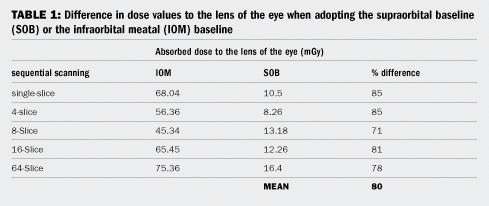
Our research with single- and multislice CT (Table 1) supports earlier studies demonstrating an 87% reduction in dose to the eye when the supraorbital baseline is used, and that sequential scanning greatly reduces the dose to the lens.11,12 This previous work was based on single-slice CT examinations, though.
A secondary aim of our research investigated the impact of MSCT on the dose delivered to the lens during routine head imaging. The routine protocol has traditionally been sequential scanning, which avoids the need to scan outside the volume of interest. This choice was largely due to equipment limitations: spiral scanning was not possible or limited on many single-slice systems.
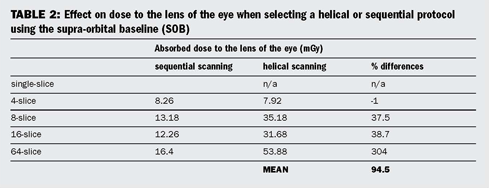
The wider availability of MSCT has now resulted in more centers switching to a helical protocol for routine head scans. An increase in dose is observed with spiral acquisition, using the supra-orbital baseline. Our data (Table 2) shows that the dose to lens of the eye increases by a mean of 94.5% (range -1% to 304%) when this technique is used, mainly due to the overscan principle. This suggests that MSCT sequential scanning should be used to reduce dose to the eye until the issue is addressed by manufacturers.
Many centers have not adopted the supraorbital baseline, despite its proven success in lowering dose to the eye. Those centers that have may still need to adopt additional dose-reduction strategies, given the increasing use of spiral scanning in head CT, and the inclusion of part of the lens on initial scan slices with single-slice CT.
Research has shown bismuth to be effective at reducing the primary radiation dose to superficial organs,13 for instance, the lens of the eye, the thyroid, and breast, without reducing the diagnostic quality of the examination.14 Evidence is mounting that in-plane shielding may protect the sensitive lens without leading to a significant increase in noise or causing artifacts on the brain images.7 Examination times do not need to be extended, and the shields are easy to use.
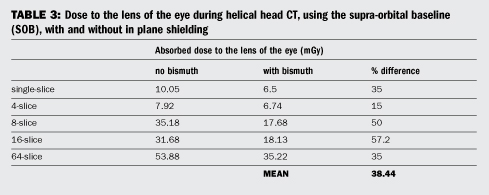
Significant reductions in dose to the eye have been observed when bismuth shielding is applied during imaging with the infra-orbital meatal baseline. Manufacturers claim that the drop in dose is 40% to 50%.13 The authors of studies reporting an 87% dose reduction through the use of the supraorbital baseline argue that shielding is not required.11,12 Our data demonstrate that whilst this may be true for sequential scanning, it is not necessarily the case with spiral CT. We observed a mean dose decrease of 37% when bismuth shielding was used (Table 3). In-plane shielding can reduce dose to the lens of the eye when using a helical scanning protocol and the supraorbital baseline.
In conclusion, using the supraorbital baseline in head CT, with sequential scanning, can reduce dose to the lens of the eye. Spiral MSCT protocols increase dose to the lens, though this can be reduced by using in-plane shielding. Shielding should also be applied when performing head CT with the infraorbital meatal baseline.
Given the growing evidence that in-plane shielding can protect radiosensitive organs during CT examinations, practitioners should surely be encouraging and developing this practice in daily routine.
The Reading Room: Artificial Intelligence: What RSNA 2020 Offered, and What 2021 Could Bring
December 5th 2020Nina Kottler, M.D., chief medical officer of AI at Radiology Partners, discusses, during RSNA 2020, what new developments the annual meeting provided about these technologies, sessions to access, and what to expect in the coming year.
Strategies to Reduce Disparities in Interventional Radiology Care
March 19th 2025In order to help address the geographic, racial, and socioeconomic barriers that limit patient access to interventional radiology (IR) care, these authors recommend a variety of measures ranging from increased patient and physician awareness of IR to mobile IR clinics and improved understanding of social determinants of health.